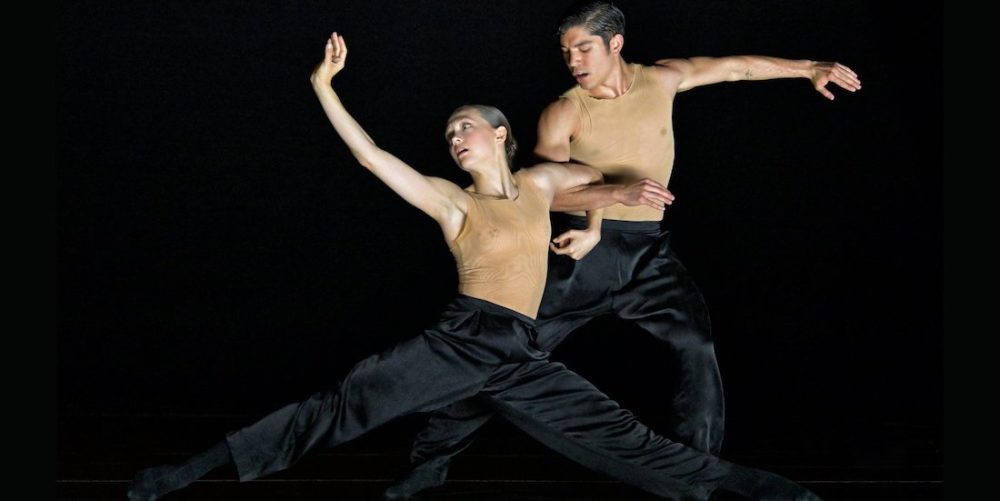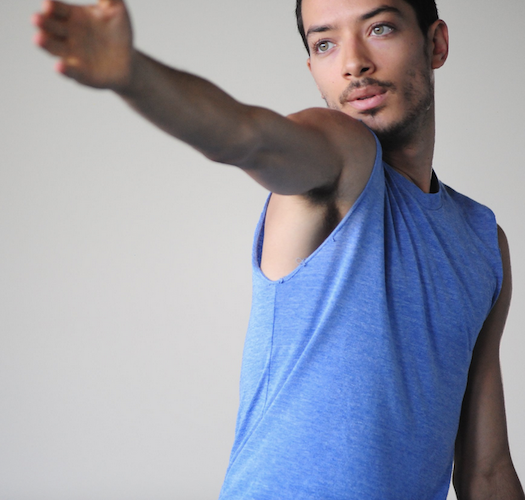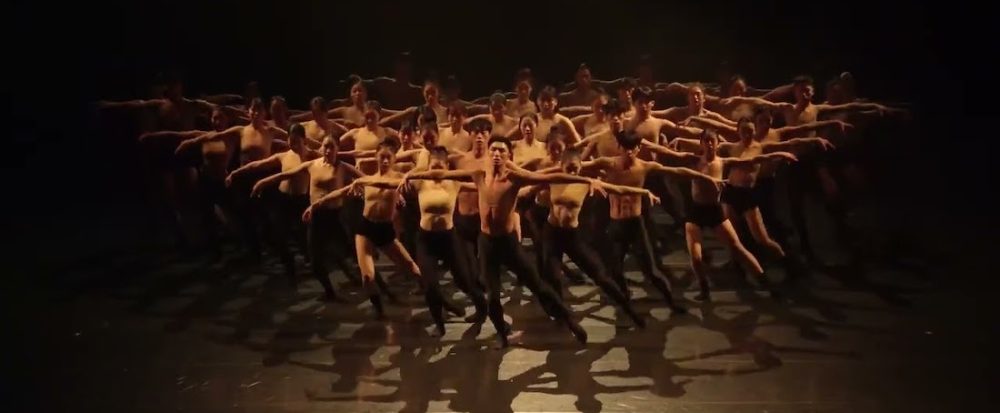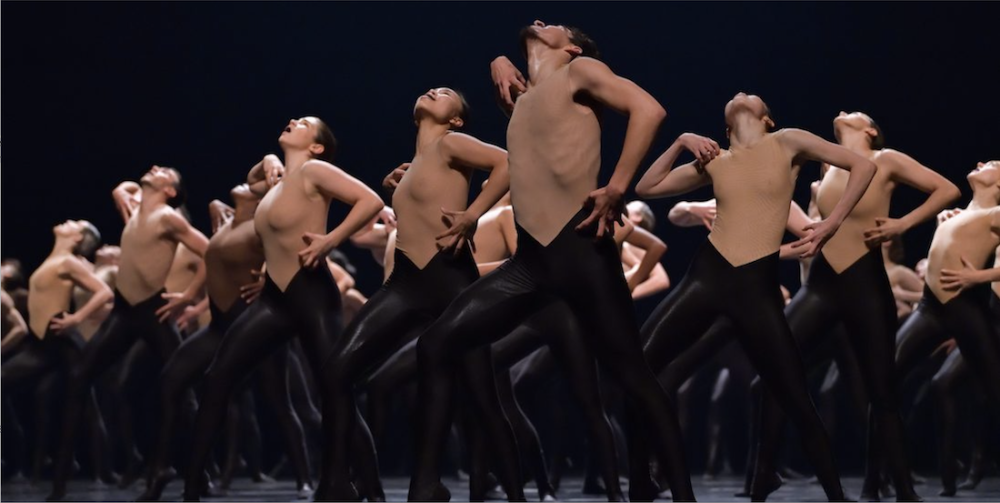
Transcending Ravel’s Repetition, Binyamini Crafts a Hypnotic Ritual of Unity and Primal Energy for Our Time
New York, N.Y. – The air thrums, a low-frequency vibration felt deep in the chest before it fully registers as sound. It begins almost imperceptibly, that insistent snare drum pattern, the heartbeat of Maurice Ravel’s Bolero.
Composed in 1928, its relentless, hypnotic crescendo is a cultural touchstone, instantly recognizable. Yet, on stage, something unprecedented unfolds. Fifty bodies, not one, respond to its call.
This is Shahar Binyamini’s BOLERO X, a monumental choreographic reimagining that transforms Ravel’s iconic score from a mesmerizing solo into a breathtaking exploration of collective human energy, temporal fluidity, and the profound power of repetition.

Binyamini, known for his large-scale, conceptually rich works, doesn’t merely set steps to Bolero; he dissects its DNA and rebuilds it as a living, breathing organism composed of human cells. His central tool, mirroring Ravel’s own, is repetition.
But where the music employs repetition structurally to build tension, Binyamini wields it choreographically as an emotional and philosophical probe. It becomes a force that dissolves linear time, revealing layers of meaning in the echoes and variations rippling through the ensemble.
The “X” in the title signifies not just multiplication but a crossing point – where history meets the present, the individual merges with the collective, and music ignites movement on a grand scale.
The Weight and Weightlessness of Collective Breath
As the familiar melody, first tentatively stated by a lone flute, begins its cyclical journey through the orchestral sections, the stage picture evolves with mesmerizing deliberation.

The fifty dancers of the House of Dance company and Zurich Dance Academy don’t move as a monolithic unit from the outset. Instead, Binyamini crafts intricate patterns of initiation and response.
A ripple starts in one corner – a contraction, a spiral, a surge towards the sky – and spreads like a wave, morphing slightly with each body it passes through. The repetition isn’t sterile; it’s organic, accumulating nuance and collective intention.
You witness the “between” moments Ravel’s score implies but leaves to the imagination: the shared inhalation before the next phrase, the collective grounding into the earth against the pull of the crescendo.
Binyamini, serving also as set and costume designer, strips away distraction. The environment is elemental, often bathed in stark light and shadow, focusing all attention on the moving bodies clad in simple, unified attire that highlights form without prescribing character.
The power resides purely in the physicality – the raw push and pull of muscle and bone against gravity, the astonishing synchronicity achieved not through robotic uniformity, but through a deep, shared listening to the music and each other. V
ideographer Roee Shalti, collaborating with Binyamini on editing, captures this not just as spectacle, but as intimate kinetic poetry, finding the human detail within the vast architectural formations.

Dissolving the Self Within the Swell
BOLERO X masterfully explores profound paradoxes. The dancers are undeniably singular – you catch glimpses of individual exertion, focus, and release – yet they are inextricably part of a pulsing whole. Movements speak of tension held and surrendered, bodies root downward only to strive upwards in moments of elevation. There is a palpable sense of struggle against the music’s inevitable drive, yet also a profound yielding to its power. This embodies the human condition itself: our simultaneous assertion of individuality and our innate need for connection, our battle with earthly constraints and our aspiration for transcendence.
The relentless build of Ravel’s score, famously criticized yet universally compelling, finds its perfect visual counterpart in Binyamini’s choreographic architecture. What might feel relentless on its own becomes, through the dancers’ embodiment, a deeply cathartic journey. The repetition ceases to be merely structural; it becomes ritualistic. Each return of the theme, amplified by more bodies and more complex interweavings, feels like an invocation, a gathering of energy. The communal breath of the dancers becomes audible, a vital counterpoint to the orchestral swell. It’s not just about the climactic release Ravel engineers, but about the collective effort, the shared vulnerability, and the sustained tension required to reach it.

A Ritual Reawakening for the 21st Century
Binyamini’s work is unequivocally a homage to Ravel’s masterpiece. It respects the score’s integrity, its hypnotic power, its place in music history. Yet, BOLERO X is far more than dutiful tribute. It is a bold declaration of dance’s unique ability to reawaken and reinterpret the past, making it vibrantly relevant for the present. In an era often defined by fragmentation and digital isolation, the sight of fifty individuals moving as one resonant body, driven by a shared primal pulse, feels radical. It taps into ancient energies – the tribal circle, the ecstatic rite – recontextualized for the contemporary stage.
The final moments, as the music reaches its crashing, almost unbearable climax, are a testament to this power. The stage is a seething mass of humanity, individual bodies discernible yet utterly consumed by the collective surge. It’s an image of overwhelming unity, a physical manifestation of the score’s final, glorious resolution. And then, silence. The held breath releases. The ritual is complete. BOLERO X leaves the audience not just entertained, but transformed, reminded viscerally of the profound forces – of connection, resilience, shared breath, and relentless drive – that move within and between us all. It is a potent reminder that sometimes, to understand the present and glimpse the future, we must first deeply listen to, and collectively embody, the powerful echoes of the past.
Summary
In Shahar Binyamini’s BOLERO X, Maurice Ravel’s iconic 1928 score pulses anew through fifty dancers. This monumental choreography transforms repetition into a hypnotic ritual, exploring unity, individuality, and primal energy. Binyamini dissolves time, weaving history with the present, as the collective breath and raw physicality of the House of Dance and Zurich Dance Academy performers create a powerful meditation on the forces connecting humanity. It’s a breathtaking homage reawakened for our time.
#BoleroX #ShaharBinyamini #ContemporaryDance #RavelBolero #DanceRitual
#MassChoreography #ZurichDance #HouseOfDance #CollectiveArt #DanceInnovation
TAGS: Shahar Binyamini, Maurice Ravel, contemporary choreography, large-scale dance, House of Dance,
Bolero, Zurich Dance Academy, Roee Shalti, dance film, ritual performance, collective movement, repetition in art
